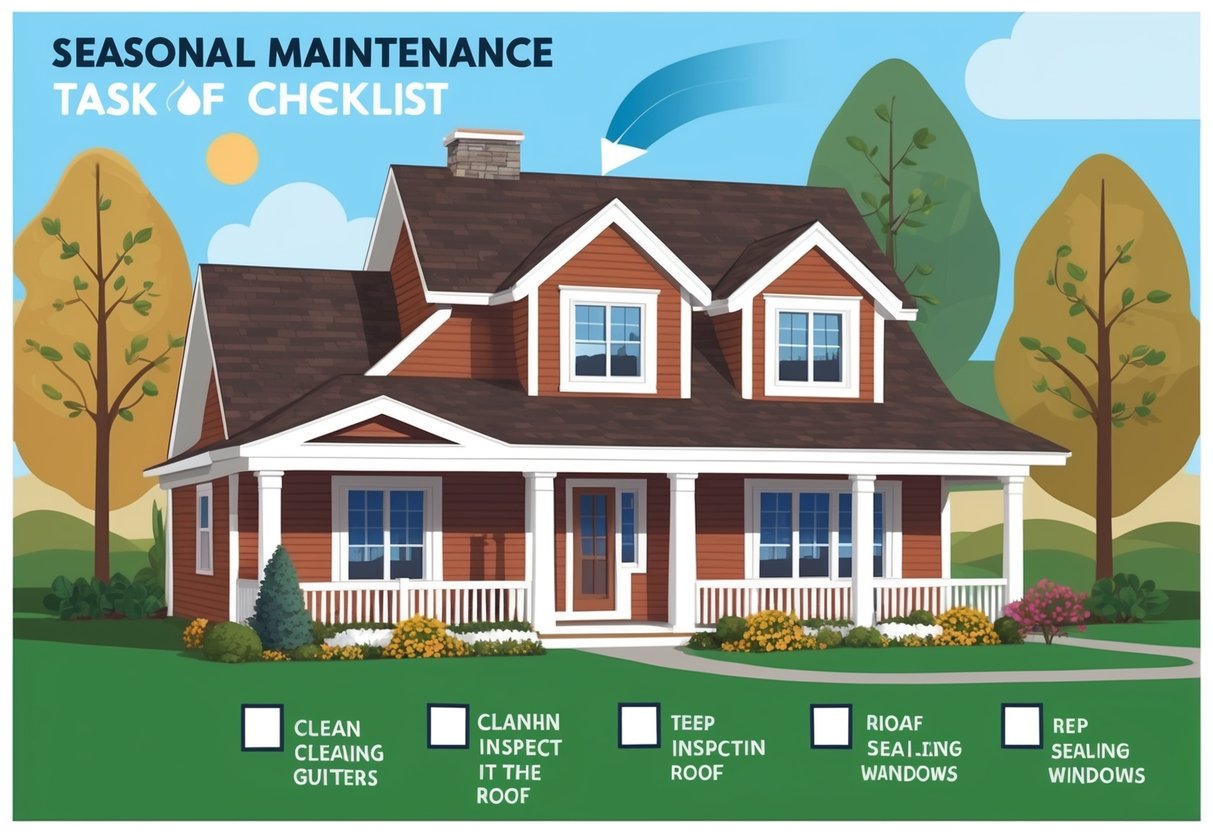
Repairing Walkways and Driveways
Cracks in walkways and driveways can allow water to seep into the base material, leading to further damage through freeze-thaw cycles and erosion. Regularly inspecting concrete, asphalt, or paver surfaces for small gaps or uneven areas helps homeowners address issues before they become safety hazards.
Important steps include:
- Cleaning debris and moss during spring and summer.
- Sealing cracks with appropriate filler.
- Resurfacing large areas that have deteriorated.
These simple home improvement practices help extend the lifespan of hardscaping, reduce trip hazards, and keep curb appeal high. Maintaining these surfaces reduces future repair costs and complements the home’s exterior appearance, as demonstrated in detailed maintenance checklists.
Caring for Landscaping
Healthy landscaping not only enhances property appearance but also protects the home from water-related damage. Seasonal yard care should include trimming shrubs and trees away from roofing and siding, which prevents branches from scraping surfaces and keeps pests at bay.
Regularly removing leaves and debris from lawns, flower beds, and gutters aids drainage and reduces the likelihood of mold growth near the home’s foundation. Aerating lawns in spring and fall supports healthy grass growth and improves water infiltration.
Edge planting beds, replace mulch as needed, and monitor for invasive weeds throughout the growing season. For best results, homeowners should incorporate landscaping tasks into their seasonal home maintenance plan to protect against foundation issues and maintain a tidy, inviting outdoor environment.
Energy Efficiency Improvements

Addressing common sources of energy loss in the home helps reduce monthly energy bills and can prevent long-term damage to critical systems. Efficient practices not only save money but also increase comfort during extreme temperatures.
Sealing Drafts with Caulk and Weatherstripping
Drafts around windows and doors can lead to a notable rise in heating and cooling costs. Applying caulk to seal gaps and cracks is an effective solution for preventing air leakage.
Homeowners should inspect the perimeter of windows, doorframes, and baseboards for any visible spaces, using acrylic or silicone caulk for the best seal. Weatherstripping further improves energy efficiency by adding a physical barrier to stop air movement around movable parts, like the edges of doors and windows.
Properly installed weatherstripping can save an average of 20% on heating costs, according to this seasonal home maintenance checklist. Regularly checking and replacing deteriorated caulking and weatherstripping is crucial.
The right products ensure a tighter seal and better home insulation. This routine maintenance improves both comfort and utility efficiency year-round.
Upgrading Insulation
Insulation acts as a thermal barrier, reducing the amount of heat lost in winter and minimizing heat gain in summer. Areas like attics, crawl spaces, and exterior walls should be evaluated first.
Homes built before modern building codes often lack sufficient insulation, leading to higher energy consumption. Insulation comes in various forms, including fiberglass batts, blown-in cellulose, and rigid foam boards.
Each offers specific benefits for different zones within the home. Upgrading to higher R-value products enhances thermal resistance and maximizes energy-saving potential.
A professional energy audit can help determine where insulation upgrades are most needed. This step ensures improvements target areas with the highest heat transfer, optimizing energy efficiency and comfort.
Optimizing Appliance Performance
Household appliances such as HVAC systems, water heaters, and refrigerators play a large role in overall energy usage. Regular maintenance extends an appliance’s lifespan and maintains its energy efficiency.
Essential tasks include replacing air filters, cleaning refrigerator coils, and flushing water heaters to prevent sediment buildup. An annual inspection of HVAC units can reveal issues before they escalate and lead to higher energy bills.
When an appliance approaches the end of its service life, upgrading to an ENERGY STAR-rated model can offer significant energy savings. Homeowners can further optimize performance by using programmable thermostats and smart plugs to ensure appliances run only when needed, reducing wasted electricity and wear.
Interior Home Upkeep and Preventive Repairs

Effective interior home upkeep can avoid expensive repairs and extend the life of household systems. Regular maintenance ensures a healthier and safer home by targeting issues before they escalate into major problems.
Spring Cleaning Strategies
A comprehensive spring cleaning plan should tackle dust, debris, and allergens built up over the winter months. Start by deep cleaning carpets, floors, and upholstery.
Dust ceiling fans, light fixtures, and vents as these can harbor allergens and reduce air quality. Decluttering closets, cabinets, and storage spaces creates a more organized living area.
Clean behind appliances like refrigerators and stoves—these hidden areas often collect grime and can attract pests. Inspect windows and doors for leaks and weather-stripping issues.
This helps improve energy efficiency and prevents moisture intrusion. Organizing a checklist can help ensure that all interior areas receive attention.
For a structured approach, see this home maintenance checklist.
Checking for Mold and Mildew
Mold and mildew thrive in damp, poorly ventilated spaces such as bathrooms, basements, and laundry rooms. Regularly examine walls, ceilings, and floor corners in these areas for discoloration or musty odors, which can indicate hidden growth.
Immediate action is crucial if any signs appear. Use a mixture of water and detergent or a commercial mold remover to clean affected areas.
Repair leaks under sinks, in the attic, or around windows to stop the conditions that allow mold to flourish. Ventilating bathrooms with exhaust fans and using dehumidifiers in basements helps control humidity levels.
Continuous monitoring and prompt cleaning are key aspects of home maintenance to protect indoor air quality.
Routine Appliance Maintenance
Appliances need regular maintenance to function safely and efficiently. Clean dryer vents every few months to prevent lint buildup, which is a common cause of household fires.
Replace HVAC filters quarterly, or as recommended by the manufacturer, to help the system operate at peak efficiency. Check the condition and seals on refrigerators and freezers to minimize energy loss.
Run self-cleaning cycles on ovens and dishwashers to extend their lifespans and improve performance. By scheduling inspections and maintenance for major appliances—such as water heaters, washing machines, and HVAC systems—homeowners can detect small problems before they become larger and more expensive to fix.
For a comprehensive year-round schedule, refer to this seasonal home maintenance checklist.